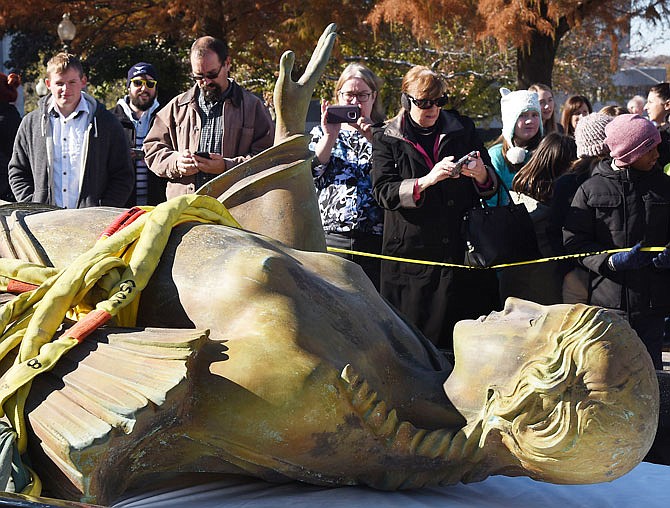It took about 35 minutes, from the first warning horn that the statue was being lifted off the Capitol Dome until it was laying on a padded surface on a flatbed trailer on the ground.
Photo Gallery
Business of Art
A reception at Pulaski Tech to fund scholarships for students majoring in Business or pursing a career in Fine Arts. Honoring local artist John Deering and held at Pulaski Tech April 9.
The 10-foot, 4-inch bronze statue of Ceres - the Roman goddess of agriculture, grain crops, fertility and motherly relationships - came down "without any problems, whatsoever," Cathy Brown told reporters early Thursday afternoon. "The process was very intricate."
Brown, director of Missouri's Division of Facilities Management, Design and Construction in the Office of Administration, added: "It took a lot of time" to make sure there wouldn't be problems with the statue's removal.
"This isn't something you just go up and wrap some straps around the statue and remove her," she said.
For several hours, beginning before 7 a.m., work crews began removing the 1-ton statue from its base on the dome, and preparing it for the 550-ton crane to lift it off the base and transfer it to the waiting flatbed trailer.
"The people that you saw on the top of the Capitol throughout the entire morning," Brown explained, "consisted of contractors, structural engineers, architects, the conservator and a safety engineer. I was in the job trailer at 6 a.m., with the entire team, going over every single detail that needed to occur."
Christine Roman was visiting from Sacramento, California, when she heard about the project to remove Ceres - and came to the Capitol grounds about 8 a.m. to watch.
"It was awesome," she told the News Tribune, adding the "whole experience of everybody here, witnessing her coming off the building, was pretty fantastic."
Sean Asbury, who works in construction, also watched the statue come down.
"It was very impressive," he said. "These guys were playing it safe. There was a chance it could have come loose on top - but very slim. They did a fine job."
Theresa Atkins, a teacher at St. Peter Elementary School, was monitoring a group of first- and third-graders as they walked past the flatbed holding the bronze statue.
"I think this is just a once-in-a-lifetime opportunity," she said, "so we had to come see it - since we're so close."
Even at their young ages, "it will be cool (for the students) to say they have seen it and, when they see it (back) on top of the Capitol, to know that they saw it up close and personal - when no one else will be able to say that," Atkins said.
Historian Bob Priddy, whose books include "The Art of the Missouri Capitol," which includes a section about Ceres, was impressed with the work done to remove it.
"I've been telling people it's not every day that a goddess comes to Earth in Jefferson City," he quipped.
Priddy was glad for the opportunity to see the statue up close, after admiring its half-size model at the University of Missouri-Columbia's Museum of Art and Archaeology. Sculptor Sherry Fry created the half-size model to show the Capitol Decoration Commission what he wanted to do.
"I have always been in love with that statue - it's such a stunningly beautiful woman," Priddy said.
Frankie and Glenn Ryan planned their day around the statue's removal.
"I'm glad I was here for this - I truly am," Frankie said. "I think this is a significant day. Our Capitol has been needing this for awhile. And the statues have, definitely, been needing this for awhile."
Glenn added: "I've heard all kinds of stories about her, over the years - little, humorous ditties and things. We heard about what they were doing, and said, 'We've got to come down and see this!'"
He noted that, from a distance, Ceres looks "entirely different" than what people could see standing only a few feet away.
Standing near the head-end of the statue as it lay on the flatbed, Frankie said: "She looks pretty good for 94 years old."
Both said they're looking forward to seeing the statue again in a year after it has been restored.
After her public viewing on the flatbed trailer, Ceres was to be transferred to a box truck and "shipped off - carefully," Brown said, to the Conservation of Sculpture and Objects Studio Inc. in Chicago.
"The conservator is an expert in their field," she said. "They use a system with a laser treatment - in fact, they just patented that system and received that patent just this March. It's a non-abrasive system - there will be much waxing of the statue. And when she comes back, she will look really, just beautiful again."
As plans stand now, Brown said, the public will get another chance to view the renovated statue before she's returned to the top of the dome.
Priddy noted the Roman legend that Ceres leaves Earth for a period of time each year.
"It's appropriate that she comes down at this time of year because this is when Ceres disappears into the Underworld and winter comes," he said. "Maybe they'll bring (the statue) back in March, when spring is supposed to arrive, so it will be appropriate."
But, Brown said, the statue likely will be returned to the top of the dome about this time next year - near the beginning of winter, not its end.
"The time of year has no impact on when she can be installed," she said. "Only the wind speed for crane usage is what we were really tracking, first thing (Wednesday) morning."
The overnight snowfall wasn't enough of a problem to interfere with the removal plans.
Some have speculated that when Ceres was placed on the Capitol Dome on Oct. 29, 1924 - 94 years and 18 days ago - she was facing the wrong way.
Priddy said: "I've never found any documentation that says that. As far as I know, (facing south) is the way she was intended to be."
Although, he added, he could understand why some feel the goddess of agriculture "should be facing the great, agricultural north, (not) the rocky, Ozarks south (because) the great agriculture area of Missouri is to the north."
And, Brown said, when she's returned to the top of the Dome about a year from now, "She's still going to be facing to the south, as she has always been for the last 94 years."


